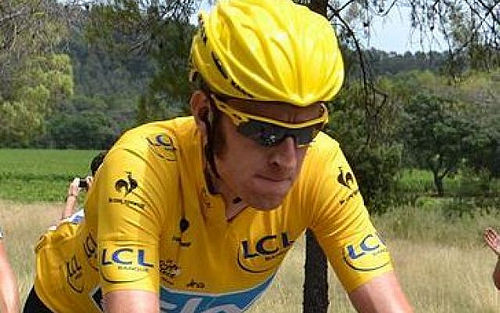
There are things I write about because I want to and there are things I write about because I think it’ll look weird if I don’t. This is the latter.
Don’t get me wrong. It’s not that I don’t want to write about this. I’ll write about any old shit.
The background
You’ll most likely know all this already, so let’s keep this short. Fancy Bears, the Russian hackers, released details of Sir Bradley Wiggins’ therapeutic use exemptions (TUEs). Cycling’s governing body permitted him to have corticosteroid injections to treat asthma before the 2011 and 2012 Tours de France and before the 2013 Giro d’Italia.
Was using this drug cheating?
Not in a technical sense because he asked to use it and they said he could. People are however wondering why this particular drug and why at those times.
Why this particular drug and why at those times?
This is trickier. From all that I’ve read, the injection of triamcinolone very much falls into nut-cracking-with-sledgehammers territory. Most people make do with inhalers and Wiggins himself had other TUEs for inhalers in the past.
If I were to offer an explanation (not a defence), I would say that Team Sky had so much vested in Wiggins’ success that they didn’t want to leave anything to chance. They wanted to guard against his developing any kind of breathing problem during those races.
I myself use corticosteroid spray for nasal inflammation. Don’t ask me what causes the problem, I have no idea. All I know is that sometimes it gets worse, even when I use the spray regularly (and I’m pretty sure that a large volume of cycling can exacerbate it).
Point is, sometimes you need something stronger than your normal treatment and the imminent prospect of shitloads of heavy breathing (not like that, you deviants) might persuade you that a preventative measure might be a good idea. The spray takes a few days to really kick in. Maybe this injection’s the same.
Is there any chance that Team Sky chose this particular drug for the performance benefits?
I can’t really say no to that – of course there’s a chance. However, on balance, I’d be more inclined to say that the motivation was the asthma reason stated and that they took a ‘better safe than sorry’ attitude for the reasons given above. It might not seem proportional, but no-one can argue that sledgehammers don’t crack nuts very effectively indeed.
On the other hand, even if we assume no nefarious motive, as a somewhat nauseatingly pious cycling team, Sky should have known that this kind of treatment had previously been used by confessed dopers. Surely it would have been better to steer clear of it altogether?
What are the performance benefits of triamcinolone?
Well there’s a question. Wiggins himself has argued that he took less than a doper would and didn’t ‘abuse’ the drug (although quite what this means beyond using a greater amount, I’m not entirely sure – slagging it off maybe?). I was thinking he’d used a fraction of the amount, but in an interview with Cycling Tips, Jorg Jaksche said he doped with 50mg while Wiggins’ dose was 40mg.
That doesn’t seem much different to me, particularly when we’re talking about a drug which Michael Rasmussen told Newsnight would ‘drain’ the body of fat – and Rasmussen of all people knows precisely what that means. David Millar said something similar, telling The Telegraph that he could lose 1.5-2kg on it in a week.
At the same time, there’s the argument that a drug that eats you is only of benefit as one part of a richer cocktail. Again speaking to The Telegraph, Dr Brian Lipworth of the Scottish Centre for Respiratory Research said:
“An anabolic steroid like testosterone puts on muscle mass but this is a catabolic steroid which breaks down muscle. The benefits to David Millar were probably the fact that he was taking EPO and testosterone at the same time as he was using triamcinolone. So the anabolic effect of the testosterone probably counteracted the triamcinolone.”
There is zero evidence that Wiggins was taking anything else. Even the stuff we’re asking questions about was declared.
What about the ‘no needles’ lie?
In his autobiography, Wiggins said he’d never had an injection other than vaccinations and being put on a drip. I do wonder whether he’s just been explaining this badly since.
In the bad old days, there was always a thing in cycling where riders had injections for recovery – nothing sinister, just vitamins and whatnot. The practice fairly obviously smoothed the path to also injecting something that was against the rules. British Cycling was always against this and that’s what Wiggins seemed to be talking about in his autobiography. ‘I’ve only had injections for serious stuff’ was the gist to my eyes.
For some, Wiggins’ shaky explanations about this element are the most damning aspect in all of this, but it’s actually a part where I’d probably be inclined to give him the benefit of the doubt.
So where does that leave us?
Buggered if I know.
My take is basically that Sky were so hell-bent on winning that they lost sight of their own holier-than-thou philosophy. I don’t think they used the drug for performance enhancement, but I do think they massively overdid it in trying to guarantee nothing went wrong with their masterplan.
Having received the go-ahead from cycling’s governing body to use the drug once, they could convince themselves there were no issues, while a precedent was set to do it again.
It isn’t a complicated web of lies surrounding an elaborate doping programme. It’s probably just a team being given permission to go overboard with medical treatment through the use of an inappropriate drug.

Leave a Reply